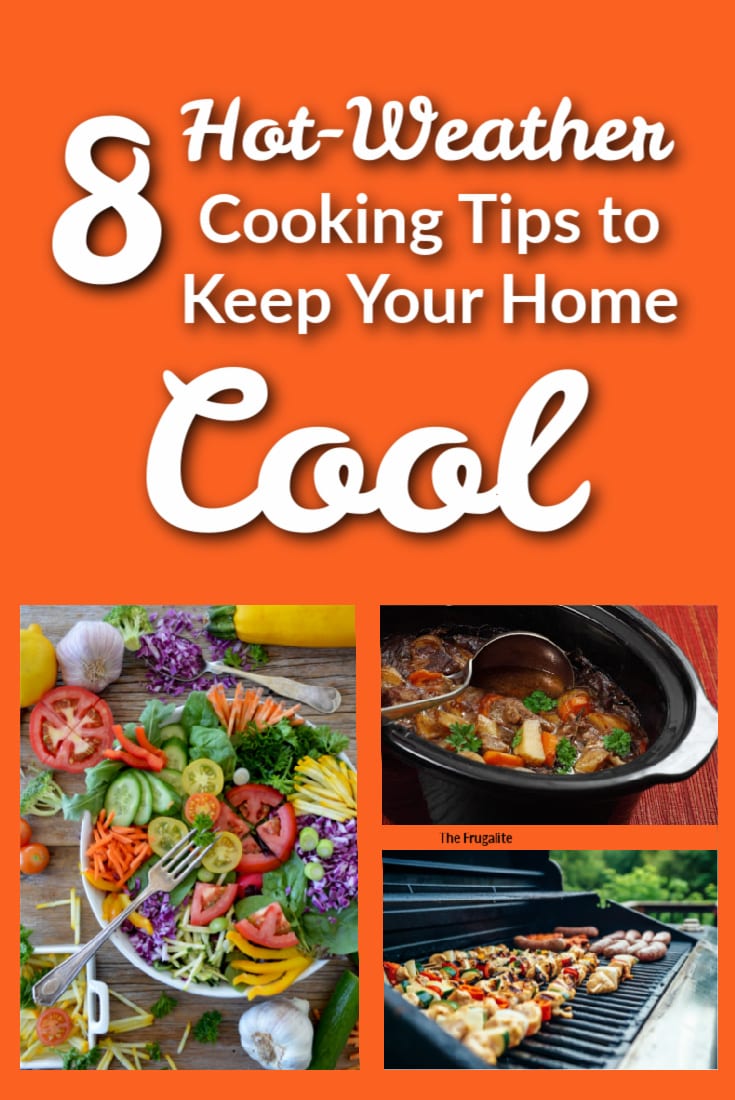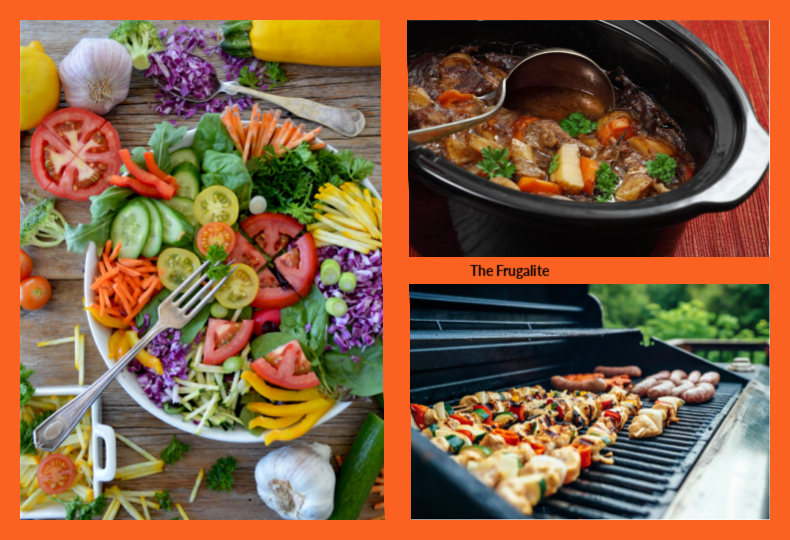(Psst: The FTC wants me to remind you that this website contains affiliate links. That means if you make a purchase from a link you click on, I might receive a small commission. This does not increase the price you’ll pay for that item nor does it decrease the awesomeness of the item. ~ Daisy)
It’s midsummer and the mercury is rising! As the electrical power grid struggles to meet the high demands of central air conditioners battling the heatwave, these hot weather cooking tips can help you to keep your cool without cranking the air even higher.
Cooking is the activity that adds the most ambient heat to your home, followed by running a dryer. Your choice of cooking methods can greatly increase the temperature in your house, and then your air conditioner must work harder to overcome it. This can add a lot to your electric bill, and worse, if you have no air conditioner, choosing the wrong cooking method can make your home humid, muggy and miserable.
Hot Weather Cooking Tips
Now is the time to seek some different kitchen strategies. We can look back in history for a guideline, based on what our pioneer ancestors ate. Foods were lighter and required less cooking since nearly all cooking was done on a wood-burning stove that would have made the house unbearable. As well, many people set up summer kitchens, consisting of either a separate building to keep the main house cooler or an outdoor fireplace. We can take our cues from them and adapt their diets to our modern lifestyles.
- Change your eating habits with the thermometer. As the weather warms up, the harvest from your garden will increase. Most summer vegetables require little, if any, cooking, and can generally be quickly steamed to perfection on the stovetop. Look for easy, no-cook recipes and fast non-processed foods.
- Break out the kitchen gadgets. Instead of firing up the oven, or cooking something for hours on the stove top, pull out those dusty, seldom-used kitchen gadgets. Toaster ovens
, countertop grills
, and slow cookers
can all make meals without heating up the house. If I am going to be gone for the day, I often put something in the crock pot for a nice meal to welcome us home. (I’ve included a couple of our favorite recipes below.) The low heat of the crock pot will not affect the temperature in your home, and it’s a great way to tenderize a less expensive cut of meat, to which you can add some fresh veggie sides at dinner time. Skip the roasting and baking during the summer.
- Always make enough to have leftovers. Leftovers are a goldmine for speedy future meals. They generally require just a quick heat in the toaster oven or on the stovetop, and some foods are delicious when compiled into a cold salad or rolled up in a flatbread.
- Take it outside. Use a barbecue, a solar cooker
, or an outdoor fireplace to cook your meals in the summer, keeping all of the cooking heat outdoors. If you are grilling meat outdoors, make extra to add some quick protein to your salads. Here are more tips for cooking thrifty meals outdoors.
- Focus on local abundance. Even if you don’t have a garden, you can still have delicious local produce. Hit your farmer’s market and plan your menus around the seasonal goodness found there. (Find farmers and markets in your area HERE!) Enjoy summer fruits and vegetables like berries, cucumbers, peaches, tomatoes, and much more! None of these requires much, if any, cooking time. Just wash and eat!
- Try different protein options. Look for delicious plant-based sources of protein. Beans picked fresh from the garden won’t require nearly as much cooking time as the dry ones sitting in your pantry. If you prefer animal products, look for quick-cooking proteins like fish, chicken cut into small pieces, and eggs. Save large oven-baked roasts for winter fare, or at the least, use an alternative cooking method.
- Enjoy the health benefits of eating seasonally. Seasonal foods provide you with exactly what you need at different times of the year. For example, in the spring, those tender leafy sprigs like lettuce, kale, peas and pea shoots, and asparagus provide vitamins K and folate, which support blood health, bone health, and cell repair. The cool delicate foods are light, low in calories, and rejuvenating to the body as you gear up for the upcoming warm weather. Feasting on these waistline-friendly foods is a great way to get rid of that insulating layer of fat that you may have acquired during the winter.
- You’ll save money in more ways than one. Not only will your electric bill be reduced by adjusting your summer eating habits, but so will your grocery bill. Seasonal foods are less expensive by nature of their abundance at a given time. Farmers MUST sell them quickly or they’ll spoil. So you can often purchase them in large quantities at rock bottom prices. And if they come directly from your garden, it’s even better for your wallet!
What do you think?
Do you have any hot-weather cooking tips? Please share them in the comments.












8 thoughts on “8 Hot-Weather Cooking Tips to Keep Your Home Cool”
Cook at night or early in the morning when temperatures are lower if you need to bake bread or something else that requires high temps or longer cook time.
Also cook ahead for several meals so you can just eat leftovers cold or zap in microwave.
I try cook early in the morning too.but might give the solar oven a go for the bread this coming summer. We have so many total fire ban days the grills outside often can’t be used. One day I’d love to build a summer kitchen in the garage like my nan had.
As we have meat almost every meal, I find my instant pot comes in real handy during the summer. I also would love an outside kitchen – it’s on my list!
Let’s assume just for a minute that you’re in the middle of a long term power outage — with no idea when or if it might be relieved. Assume also that you have “some” stored fuels of various types, but you’d prefer to conserve them as much as possible. OK, now what?
Consider thermal cooking. That’s a matter of heating up two vessels — one to bring your food up to cooking temperature (whatever that is) that’s not insulated, and the other with sufficient insulation so that it can remain cooking hot for several hours by itself if you want. The first vessel can be just about anything, but the second is more critical. It can be as simple as a high quality thermos bottle (the “Thermos” brand is one of the best) or if larger capacity is needed, there are several examples of thermal cooking pots on Amazon and eBay. Some of the best come from Japan.
Heat up both vessels using whatever off-grid resources you have. In solar, anything from a large parabolic solar cooker to a large Fresnel lens would do that job quickly without using up any stored fuel. Or some stored fuel (wood, propane, butane, alcohol, Esbit, etc) could do it — and you’d only need a wee bit for a very short time.
Once you have the original food vessel heated up to temperature with food inside, make sure your long term thermal cooking vessel (thermos bottle or thermal cooking pot) is up to the same temperature — and transfer your now-hot food over to it and close the lid quickly. You should now have several hours of effective slow cooking time available in that thermal vessel. With the thermos bottle, you could then easily get on the move on foot if need be. With the larger thermal cooking pot, you’d probably need a vehicle if you wanted to travel. Or you could use either one in place while you get other things done there at home or wherever. No 110vac needed.
Also with large Fresnel lenses or large parabolics, it’s very easy to heat up water quickly for dishwashing, or just for boil sanitation, eg. [Wearing very dark glasses or even acetylene welder’s goggles is a very use safety practice to prevent eye damage from any concentrated sunlight flash.] Just remember — the bigger they are, the less portable they become. But there are other kinds of solar cookers that are more portable, like the double wall vacuum evacuated glass tubes or the parabolics that fold up like an umbrella (invented in the US in the 1950s but are made mostly today in Asia — S. Korea and China).
Of course if you have a stored stockpile of non-solar fuels, that gives you some cloudy, rainy or nighttime freedom to do what I’ve described above. Thermal cooking would help you conserve such stored fuels to the maximum possible.
OR, if you don’t need the thermal benefit I’ve mentioned, you can use a solar box cooker pretty much year around. In India, they like to use box cookers like we use slow cookers here … in their belief it preserves both the taste and the nutrition much better than our Western habit of high temperature, scorch and burn methods. And their box cookers are even issued to some units of their army — that’s confidence in their equipment.
I didn’t mention the hybrid types of solar box cookers that have a built-in option of electric heating in case you lose sunlight or want to continue cooking at night. The US-made Sun Focus is one example. The India made Tulsi hybrid is another. I didn’t mention those here above because in this example we’re assuming a long term power outage.
-Lewis
Some thoughts I didn’t include when I posted back in 2020
While cooking daily is a well-established tradition with most households, there is an accomplished literature about the why and how of either once a WEEK cooking OR once a MONTH cooking. There are books on both topics in the books section on Amazon. They are old enough (well past the six months since the publisher’s release date) to be fair game for a free interlibrary loan request. If you do online searching on these topics, spell out the topic instead of using acronyms like OAMC which have been used by other people for other topics you’re not interested in.
Such choices come with implications. Do you store such foods in fridges or freezers? Is your electric power supply reliable enough to use once a week or once a month cooking of foods in quantity? If there’s a risk of long term power outages as current politics suggest, can you either switch to a propane or natural gas powered fridge system (like the anti-electricity off-grid Amish have done for decades — the lehmans.com people in Kidron, Ohio are excellent suppliers and instructors about such equipment) OR switch to recipes that will store without artificial cooling as was done in the era before refrigeration came along?
–Lewis
I use my propane grill for most of my summer cooking needs. Chicken breasts with my favorite rubs and / or marinades wrapped in heavy duty foil. Salmon or other fish, wrapped in foil. Shrimp or vegetables on skewers. Get creative with kabob type things – pineapple with chunks of leftover ham is a great treat. The sky is the limit, and you won’t heat the house up. Plug in your instant cooker or crock pot outside to eliminate even that small amount of heat. A deep fryer outside will do well, and you won’t have the oil smell inside.
Crock pots and instant cookers with teflon coating (unless stainless steel) are toxic. No point in eating healthy if you are poisoning yourself!
When I want to use my toaster oven I bring it outside and use it there… keeps the heat out of our small house ?